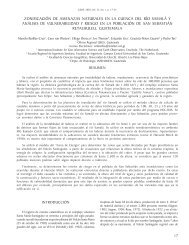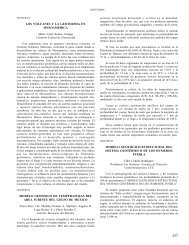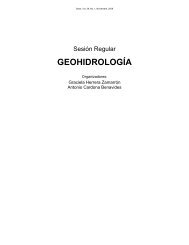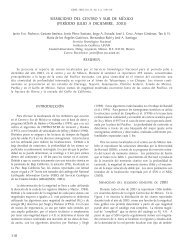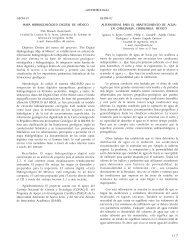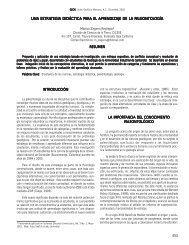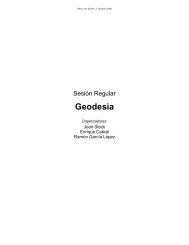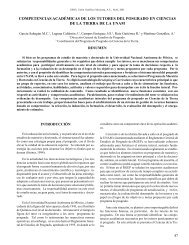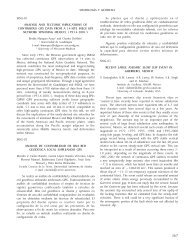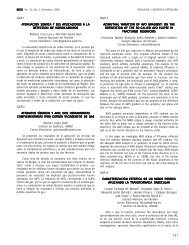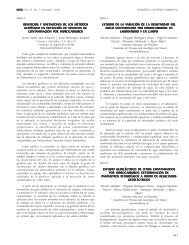GEOQUÍMICA Y PETROLOGÍA Geos, Vol. 31, No. 1, Noviembre, 2011GEOQP-1METASOMATISMO MODAL EN PERIDOTITAS DELMANTO PROVENIENTES DEL CAMPO VOLCÁNICODE SANTO DOMINGO, SAN LUIS POTOSÍ, MÉXICODávalos Elizondo María Guadalupe 1 , Aranda Gómez José Jorge 1 ,Cervantes De la Cruz Karina Elizabeth 1 y Linares López Carlos 21 Centro <strong>de</strong> Geociencias, UNAM2 Instituto <strong>de</strong> Geofísica, UNAMmgdavalos@geociencias.unam.mxEl campo volcánico <strong>de</strong> Santo Domingo se localiza en la Mesa Central, aaproximadamente 100 km al noreste <strong>de</strong> la ciudad <strong>de</strong> San Luis Potosí. El campoestá formado por al menos cuatro maares cuaternarios: Santo Domingo, Joya<strong>de</strong> los Contreras, El Banco y Joya Prieta y un cono cinerítico y <strong>de</strong>rrames <strong>de</strong> lavaasociados (La Pólvora). Las peridotitas <strong>de</strong>l manto – principalmente lherzolitas<strong>de</strong> espinela – se encuentran como xenolitos que fueron acarreados hasta lasuperficie por magmas hawaíiticos <strong>de</strong> intraplaca. Características sobresalientes<strong>de</strong> los xenolitos <strong>de</strong> Santo Domingo, en comparación con otras localida<strong>de</strong>s<strong>de</strong>l centro y norte <strong>de</strong> México, son su textura milonítica y la abundancia<strong>de</strong> megacristales <strong>de</strong> kaersutita y <strong>de</strong> algunos fragmentos <strong>de</strong> hornblenditapegmatítica. Xenolitos compuestos, en don<strong>de</strong> vetillas <strong>de</strong> hornblendita cortan ala foliación milonítica en las peridotitas, <strong>de</strong>muestran que las fases hidratadasprovienen <strong>de</strong>l manto.En México el estudio <strong>de</strong> xenolitos <strong>de</strong>l manto se ha enfocado principalmenteen compren<strong>de</strong>r el origen <strong>de</strong> las variaciones texturales en las peridotitas, ensu composición química global y en las condiciones <strong>de</strong> P-T <strong>de</strong> equilibrio <strong>de</strong>las mismas. Así mismo, se ha investigado el aspecto geológico-estructuralresponsable <strong>de</strong> traerlos a la superficie. Sin embargo, el enten<strong>de</strong>r los procesosmetasomáticos asociados a interacción mineral-fluido-fundido en el mantolitosférico se ha abordado muy poco y sólo <strong>de</strong> manera aleatoria. Una excepciónnotable son las peridotitas metasomatizadas <strong>de</strong> El Peñón investigadas porBlatter y Carmichael (1998).El fenómeno metasomático suele transformar la composición mineralógica yquímica <strong>de</strong> una roca que ha estado bajo el efecto <strong>de</strong> fluidos y/o fundidos.El metasomatismo modal en xenolitos <strong>de</strong>l manto – como el observado enalgunos xenolitos <strong>de</strong> Santo Domingo – ha sido estudiado ampliamente enlocalida<strong>de</strong>s <strong>de</strong> rocas alcalinas y en kimberlitas, en Europa Central y en Sudáfricarespectivamente. Los minerales más comunes asociados a este fenómeno sonfases hidratadas <strong>de</strong> anfíbol y mica (p. ej. kaersutita, pargasita y flogopita),así como óxidos <strong>de</strong> Fe-Ti como ilmenita y rutilo junto con apatito, a<strong>de</strong>más <strong>de</strong>sulfuros, como pirrotita y pentlandita.Por medio <strong>de</strong>l estudio petrográfico y <strong>de</strong> la química mineral se interpreta quelos xenolitos <strong>de</strong> los maares Joya <strong>de</strong> los Contreras, Santo Domingo y JoyaPrieta, tienen texturas porfiroclásticas asociadas a <strong>de</strong>formación en el mantosuperior. A<strong>de</strong>más todos ellos tienen la característica <strong>de</strong> presentar, en mayoro menor medida, anfíbol y mica que parecen asociarse espacialmente a loscristales <strong>de</strong> espinela y clinopiroxeno; también es común observar sulfuros conformas irregulares o <strong>de</strong> “gota” en los espacios intracristalinos entre el olivinoo como inclusiones en clinopiroxeno. Algunos <strong>de</strong> estos rasgos mineralógicosy texturales sugieren: 1) que el metasomatismo sucedió en el manto superiorque subyace al campo volcánico <strong>de</strong> Santo Domingo o 2) que el mantometasomatizado en el área es un vestigio que sobrevivió a un proceso <strong>de</strong>subducción en el pasado.El estudio sistemático <strong>de</strong> xenolitos <strong>de</strong>l manto con y sin alteración metasomáticapue<strong>de</strong> mostrar cambios registrados en sus fases minerales primarias,hidratadas y sulfuros que sirvan para compren<strong>de</strong>r mejor la heterogeneidad enel manto superior.GEOQP-2CAR<strong>AC</strong>TERIZ<strong>AC</strong>IÓN GEOQUÍMICA DE GRANITOIDES PERMO-TRIÁSICOS EN SIERRA LOS TANQUES Y ZONAS CIRCUNDANTES EN ELNW SONORA, MÉXICO: INICIO DEL ARCO MAGMÁTICO CORDILLERANODEL SW DE NORTEAMÉRICA Y SUS IMPLIC<strong>AC</strong>IONES TECTÓNICASArvizu Harim E. 1 , Iriondo Alexan<strong>de</strong>r 1 , Izaguirre Pompa Aldo 1 ,Enríquez Castillo Mónica 1 , Velázquez Santelíz Andrés 2 , Paz MorenoFrancisco 3 , Pérez Arvizu Ofelia 1 y Lozano SantaCruz Rufino 41 Centro <strong>de</strong> Geociencias, UNAM2 Facultad <strong>de</strong> Ciencias <strong>de</strong> la Tierra, UANL3 Departamento <strong>de</strong> Geología, UNISON4 Instituto <strong>de</strong> Geología, UNAMharimarvizu@geociencias.unam.mxSierra Los Tanques se localiza en el NW <strong>de</strong>l Estado <strong>de</strong> Sonora, México yrepresenta geológica y espacialmente uno <strong>de</strong> los principales afloramientos<strong>de</strong> rocas graníticas permo-triásicas reportados en esa región. Una serie <strong>de</strong>granitoi<strong>de</strong>s <strong>de</strong> edad permo-triásica (284-221 Ma) que aflora en el área <strong>de</strong>estudio y en diversas localida<strong>de</strong>s <strong>de</strong>l NW <strong>de</strong> Sonora presentan característicasgeoquímicas típicas <strong>de</strong> magmas generados en un ambiente <strong>de</strong> arco continental.Las varieda<strong>de</strong>s litológicas predominantes son las granodioritas, seguido porlas cuarzomonzodioritas y monzogranitos. Geoquímicamente, se pue<strong>de</strong>ndiferenciar dos suites graníticas principales, dividiéndose en granitoi<strong>de</strong>smelanocráticos y leucocráticos. La relación <strong>de</strong> campo existente entre los dostipos es que los melanocráticos son más antiguos ya que son cortados por losleucocráticos. Esta característica es corroborada, en la mayoría <strong>de</strong> los casos,por las eda<strong>de</strong>s U-Pb en zircones obtenidas en las muestras <strong>de</strong> ambas suites.Ambos grupos <strong>de</strong> granitoi<strong>de</strong>s tienen firmas calcialcalinas <strong>de</strong> alto potasio conun carácter metaluminoso a peraluminoso. Los diagramas <strong>de</strong> variación tipoHarker presentan correlaciones negativas con respecto a la sílice para lamayoría <strong>de</strong> los óxidos (TiO2, P2O5, Al2O3, Fe2O3, MgO, CaO y MnO),excepto para Na2O y K2O, en don<strong>de</strong> el comportamiento es constante.Estas ten<strong>de</strong>ncias son consistentes con la fraccionación <strong>de</strong> minerales comola esfena, apatito, hornblenda, biotita, plagioclasa y fel<strong>de</strong>spato, entre otros.En el diagrama <strong>de</strong> discriminación tectonomagmática Y vs. Nb, todos losgranitoi<strong>de</strong>s permo-triásicos caen en el campo <strong>de</strong> granitos <strong>de</strong> arco volcánico.Los elementos traza y tierras raras también muestran características típicas <strong>de</strong>rocas asociadas a subducción con un enriquecimiento <strong>de</strong> los elementos LILE yLREE con respecto a los elementos HFSE y HREE, respectivamente, a<strong>de</strong>más<strong>de</strong> anomalías claras <strong>de</strong> Nb-Ta. La participación <strong>de</strong> la corteza continental seve reflejada en las anomalías prominentes <strong>de</strong> K y Pb, y en menor medida <strong>de</strong>Sr, revelando la existencia <strong>de</strong> un aporte cortical significativo para su formación.Las relaciones elementales elevadas <strong>de</strong> Ba/Ta > 1000, Zr/Y > 10 y Zr/Yb > 50también apoyan un ambiente tectónico <strong>de</strong> subducción <strong>de</strong> tipo arco continentalpara la formación <strong>de</strong> los granitoi<strong>de</strong>s.Estas rocas asociadas a subducción que intruyen basamento paleoproterozoico<strong>de</strong> ~1.7-1.6 Ga en el NW <strong>de</strong> Sonora representan evi<strong>de</strong>ncia <strong>de</strong>l inicio <strong>de</strong>lmagmatismo cordillerano en el SW <strong>de</strong> Norteamérica (Laurencia) instauradoa lo largo <strong>de</strong>l bor<strong>de</strong> oeste <strong>de</strong> Pangea justo <strong>de</strong>spués <strong>de</strong> culminar los últimosestadios <strong>de</strong> la colisión entre Laurencia y Gondwana <strong>de</strong>sarrollando la suturaorogénica Ouachita-Marathon-Sonora. Este magmatismo permo-triásico esimportante para enten<strong>de</strong>r la evolución tectónica <strong>de</strong>l NW <strong>de</strong> México, ya quesu ocurrencia se asocia tentativamente a una zona <strong>de</strong> <strong>de</strong>bilidad corticalrelacionada al basamento <strong>de</strong>l Yavapai mexicano en el NW <strong>de</strong> Sonora. Elentendimiento <strong>de</strong> este pulso magmático también es <strong>de</strong> particular importanciaya que representa una fuente regional <strong>de</strong> zircones <strong>de</strong>tríticos no reconocidaanteriormente para cuencas sedimentarias mesozoicas y cenozoicas en Sonoray sur <strong>de</strong> Arizona, implicando una gran complejidad para explicar la abundancia<strong>de</strong> eda<strong>de</strong>s permo-triásicas <strong>de</strong> dichos <strong>de</strong>tritos y dificultando notablemente lasreconstrucciones paleogeográficas <strong>de</strong>l SW <strong>de</strong> Norteamérica.GEOQP-3EVIDENCE FOR MIXING OF MAGMAS DERIVED FROM MELTINGOF MULTIPLE CRUSTAL SOURCES: A LU-HF ISOTOPIC STUDYOF ZIRCONS FROM PERMIAN GRANITOIDS OF NW MEXICOArvizu Harim E. y Iriondo Alexan<strong>de</strong>rCentro <strong>de</strong> Geociencias, UNAMharimarvizu@geociencias.unam.mxThis study presents new Lu-Hf isotopic data for magmatic zircons from Permiangranitoids interpreted to be associated with the early stages of subduction inNW Mexico. In-situ microanalyses by LA-MC-ICPMS technique indicate largevariations in Hf isotopic compositions of zircons with the same age and fromthe same granitic rock sample (variation up to 15 epsilon Hf units). The rangeof initial epsilon Hf values for these Permian zircons is between -9.0 and -24.9,suggesting a mixture of magmas <strong>de</strong>rived from melting of different crustal sourcesto generate the precursor magmas that formed the granitoids. The Hf crustalmo<strong>de</strong>l ages for zircons vary in a range between 1.59–2.39 Ga, with most of thevalues between 1.6–1.8 Ga, indicating that Proterozoic basement rocks, similarto those present in NW Mexico today, were the sources of melting to form thepre<strong>de</strong>cessor magmas for the Permian granitoids. The Hf isotopic data presentedin this study indicate a complex process of crustal magma formation that cannotbe revealed from just conventional whole rock geochemical and isotopic studies(e.g., major and trace elements and Sm-Nd isotopes).Our hypothesis about the evolution of crust/mantle input in magma genesis inNW Mexico from Proterozoic to the present proposes that the mantle playedan important role in the initial stages of crustal formation (magmatism) duringthe Paleoproterozoic. Subsequently, from Mesoproterozoic to Permian time,the crust had a prepon<strong>de</strong>rant role in the generation of magmas. During theJurassic and Cretaceous periods, the crustal input in magma formation starts tobe significantly reduced in these subduction related magmas, to the point thatCenozoic felsic volcanic rocks have a large mantle component, but being thismore extreme during the Quaternary, as basaltic lavas have an asthenosphericmantle signature with no evi<strong>de</strong>nce of any crustal input in the genesis of themagmas (e.g., Pinacate Volcanic Field).68
Geos, Vol. 31, No. 1, Noviembre, 2011GEOQUÍMICA Y PETROLOGÍAGEOQP-4ORIGEN Y EVOLUCIÓN MAGMÁTICA DEL CINTURÓN DEINTRUSIVOS DE CONCEPCIÓN DEL ORO, NE DE MÉXICOGonzález Guzmán Reneé 1 , Velasco Tapia Fernando 1 , Weber Bodo 2 , Chávez CabelloGabriel 1 , Orozco Esquivel María Teresa 3 , Valencia Moreno Martín 4 y Schaaf Peter 51 Facultad <strong>de</strong> Ciencias <strong>de</strong> la Tierra, UANL2 División <strong>de</strong> Ciencias <strong>de</strong> la Tierra, CICESE3 Centro <strong>de</strong> Geociencias, UNAM4 Instituto <strong>de</strong> Geología, UNAM5 Instituto <strong>de</strong> Geofísica, UNAMcidgeo@gmail.comEl Cinturón <strong>de</strong> Intrusivos <strong>de</strong> Concepción <strong>de</strong>l Oro (CICO) es un conjunto<strong>de</strong> plutones que presentan una orientación ~E-W, situados entre el SectorTransversal <strong>de</strong> Parras y la Saliente <strong>de</strong> Monterrey, <strong>de</strong>ntro <strong>de</strong>l traspaís <strong>de</strong> laSierra Madre Oriental. Su origen se ha relacionado con la subducción <strong>de</strong> laplaca Farallón <strong>de</strong>bajo <strong>de</strong> la placa <strong>de</strong> Norte América, que se estableció <strong>de</strong>s<strong>de</strong>el Triásico Medio. Los plutones fueron emplazados en núcleos <strong>de</strong> anticlinalesy a lo largo <strong>de</strong> fallas <strong>de</strong> cabalgadura, elementos estructurales generadosdurante la <strong>de</strong>formación laramídica (Cretácico Tardío - Eoceno). Un programa<strong>de</strong> trabajo que involucró petrografía, geoquímica <strong>de</strong> elementos mayores y trazay análisis isotópico Sr-Nd, en combinación con datos reportados previamente<strong>de</strong> cartografía geológica y geocronología, revela que el CICO pue<strong>de</strong> separarseen dos sectores: (A) Complejos plutónicos <strong>de</strong> la porción oriental <strong>de</strong>l CretácicoSuperior (71 a 82 Ma), con una diversidad litológica que cubre <strong>de</strong> monzodioritaa granito <strong>de</strong> textura fanerítica a porfídica (n = 60; %SiO2 = 43.4 – 77.8; %Al2O3= 10.5 – 23.0), con características alcalinas (MALI = [%Na2O + %K2O – %CaO]= 9.3 – 14.7; Rb = 46-330 ppm; Sr = 257 – 2860 ppm) y relaciones isotópicas(n = 12) <strong>de</strong> (87Sr/86Sr)i = 0.7034 a 0.7040 y con #Ndi = 2.9 a 5.9: (1) ElPeñuelo, (2) El Saltillito, (3) Matehuapil-El Rabioso y (4) Rocamontes, y (B)Complejos plutónicos <strong>de</strong> la porción occi<strong>de</strong>ntal <strong>de</strong>l Eoceno-Oligoceno (32-45Ma), con una diversidad litológica restringida a granodiorita y cuarzodioritacon textura fanerítica (n = 15; %SiO2 = 53.5 – 72.5; %Al2O3 = 10.4 – 17.3),con características calcialcalinas (MALI = 2.7 – 5.0; Rb = 46-156 ppm; Sr =182 – 867 ppm) y relaciones isotópicas (n = 14) <strong>de</strong> (87Sr/86Sr)i = 0.7044a 0.7077 y con #Ndi = -2.2 a 2.1: (1) Concepción <strong>de</strong>l Oro-Provi<strong>de</strong>ncia, (2)El Colorado-La Pachona, (3) Melchor Ocampo, (4) Noche Buena y (5) SantaRosa. Los plutones <strong>de</strong> ambos sectores tienen características geoquímicas <strong>de</strong>granitoi<strong>de</strong>s con afinidad a un ambiente <strong>de</strong> arco continental en condicionespost-orogénicas. De acuerdo a la información generada en relación al CICOy al marco geológico regional, se propone que los plutones se <strong>de</strong>rivaron porfusión parcial <strong>de</strong> un manto enriquecido con asimilación <strong>de</strong> material cortical endos etapas: (A) la primera en el sector oriental, durante la somerización máxima<strong>de</strong>l ángulo <strong>de</strong> subducción <strong>de</strong> la placa Farallón bajo Norteamérica en el CretácicoTardío y (B) la segunda en el sector occi<strong>de</strong>ntal, durante la etapa inicial <strong>de</strong>“roll-back” <strong>de</strong> la placa Farallón ocurrida en el Eoceno.GEOQP-5CAR<strong>AC</strong>TERÍSTICAS GEOQUÍMICAS DE LA PROVINCI<strong>AC</strong>OMPLEJO PLUTÓNICO DE LA PAZ, B.C.S. YSU REL<strong>AC</strong>IÓN CON EL NOROESTE DE MÉXICOPérez Venzor José Antonio 1 , Schaaf Peter 2 , Aranda Gómez JoséJorge 3 , Lozano SantaCruz Rufino 4 y Pérez Espinoza Efraín 51 Departamento Académico <strong>de</strong> Geología Marina, UABCS2 Instituto <strong>de</strong> Geofísica, UNAM3 Centro <strong>de</strong> Geociencias, UNAM4 Instituto <strong>de</strong> Geología, UNAM5 Universidad Autónoma <strong>de</strong> Baja California Sur, UABCSjaperez@uabcs.mxEn este trabajo se exponen los resultados <strong>de</strong> la geoquímica <strong>de</strong> elementosmayores y elementos trazas <strong>de</strong> las muestras analizadas <strong>de</strong>l Complejo Plutónico<strong>de</strong> La Paz. La mayoría <strong>de</strong> ellas <strong>de</strong> carácter peraluminoso con una minoríametaluminosa. El diagrama AFM <strong>de</strong>fine un patrón típico <strong>de</strong> rocas pertenecientesa la serie calcoalcalina o subalcalinas. Son rocas <strong>de</strong>l campo <strong>de</strong> granitos <strong>de</strong> arcosvolcánicos (volcanic-arc granites, VAG). Las tierras raras presenta un patróntípico <strong>de</strong> rocas asociadas con procesos <strong>de</strong> subducción, con participación <strong>de</strong> lacorteza continental y <strong>de</strong>l manto superior en su génesis.Se reportan 15 nuevos fechamientos, obtenidos por Rb-Sr y Sm-Nd, enminerales y roca entera. Las eda<strong>de</strong>s obtenidas a partir <strong>de</strong> biotita-roca entera porel método Rb-Sr varían <strong>de</strong> 77.3 ±1.5 Ma a 58.7 ± 1.15 Ma. Las biotitas <strong>de</strong> lasrocas metamórficas (ortogneis Boca <strong>de</strong> La Sierra y gneis anfibolítico La Palma),dieron eda<strong>de</strong>s <strong>de</strong> 75.5 ± 1.5 Ma y 73.8 Ma ± 1.45 Ma.La isócrona calculada en roca entera por Rb-Sr, <strong>de</strong> cuatro rocas da una edad<strong>de</strong> 79 ± 12 Ma con valor inicial <strong>de</strong> 87Sr /86Sr <strong>de</strong> 0.70590 ± 0.00035, mientrasque la isócrona para siete dio una edad parecida <strong>de</strong> 80.8 ± 2.6 Ma con un valorinicial 87Sr /86Sr <strong>de</strong> 0.70680 ± 0.00072. Ambos valores indican la edad <strong>de</strong>cristalización magmática y también representan un pulso magmático regional enla provincia Complejo Plutónico <strong>de</strong> La Paz y que se relaciona con el magmatismo<strong>de</strong>l NW <strong>de</strong> México:Sonora, Sinaloa y Jalisco.Los datos isotópicos <strong>de</strong> Rb-Sr y Sm-Nd <strong>de</strong> 16 muestras <strong>de</strong> roca entera presentanrelaciones iniciales <strong>de</strong> 87Sr/86Sr y <strong>de</strong> 143Nd/144Nd que varían <strong>de</strong> 0.70452 a0.70755 y entre 0.51218 y 0.51284, respectivamente, que implican participación<strong>de</strong> una fuente <strong>de</strong>rivada <strong>de</strong>l manto y <strong>de</strong> materiales corticales en diferentesestadios <strong>de</strong> evolución.Las eda<strong>de</strong>s mo<strong>de</strong>lo <strong>de</strong> tNd (TDM) muestran un amplio rango, dando evi<strong>de</strong>nciaque diferentes materiales corticales fueron involucrados en su origen. Lasrelaciones #Nd vs 87Sr/86Sr <strong>de</strong>finen dos poblaciones: una presenta los valoresmás negativos y correspon<strong>de</strong> al campo <strong>de</strong> corteza continental antigua. Lasegunda, con valores menos negativos la ubica en el campo <strong>de</strong> cortezacontinental superior joven.La Provincia Geológica Complejo Plutónico <strong>de</strong> La Paz comparte muchas <strong>de</strong> lascaracterísticas geoquímicas con el NW <strong>de</strong> México: Sonora, Sinaloa, Jalisco ySierras Peninsulares.GEOQP-6PETROGRAPHY, GEOCHEMISTRY, AND U-PB AGES OFTHE EL CALVARIO-LA PALMA MAFIC AND ULTRAMAFICSUITE, COASTAL GUERRERO: EVIDENCE FOR A MAJOREOCENE EXTENSIONAL EPISODE IN SOUTHERN MEXICO?Ferrari Luca 1 , Ferrario Alfredo 2 , Tunesi Annalisa 3 , MartiniMichelangelo 4 , Bergomi Maria 3 y López Martínez Margarita 51 Centro <strong>de</strong> Geociencias, UNAM2 Dipartimento Scienze <strong>de</strong>lla Terra, Universitá di Milano, Italy3 Dipartimento Scienze Geologiche e Geotecnologie, Università di Milano-Bicocca, Italy4 Instituto <strong>de</strong> Geología, UNAM5 División <strong>de</strong> Ciencias <strong>de</strong> la Tierra, CICESEluca@geociencias.unam.mxThe western coast of Guerrero, between Zihuatanejo and Acapulco, preservesa large variety of lithologic types that inclu<strong>de</strong>s volcanoclastic, volcanic,subvolcanic, intrusive, ultramafic, and low- to medium-gra<strong>de</strong> metamorphicrocks traditionally explained by the juxtaposition of two different terranes: thevolcano-sedimentary to low-gra<strong>de</strong> metamorphic Guerrero terrane to the west,and the low- to medium-gra<strong>de</strong> metamorphic and plutonic Xolapa terrane tothe east. These pre-Tertiary basement units are intru<strong>de</strong>d by Paleocene toEarly Eocene continental arc granitoids. One intriguing feature of this regionis the occurrence of at least six, 5 to 7 km-wi<strong>de</strong> mafic intrusive bodiesexposed between El Calvario beach and La Palma ranch. These bodies cutthe volcano-sedimentary rocks of the Guerrero terrane as well as the plutonicand metamorphic rocks of the Xolapa terrane, and produce a 500 to 100m-thick contact aureole, with the highest temperature rocks represented bygarnet-clinopyroxene hornfels. The mafic bodies vary in composition fromolivine-orthopyroxene-clinopyroxene gabbros to horneblen<strong>de</strong>-biotite diorites.Myrmekitic structures are very common in plagioclase at the submillimeter-scale,suggesting a shallow emplacement of magma. The N-MORB normalizedmulti-element patterns show typical arc characters, with enrichment of the largeion lithophile elements (LILE) relative to the high field strength elements (HFSE),and negative Nb-Ta anomalies. Similarly, light rare earth elements (LREE) areenriched with respect to heavy rare earth elements (HREE) (La/Yb = 2.59-5.55).Zircons separated from one granite intru<strong>de</strong>d by one of the mafic intrusion and twodiorite samples associated with the mafic bodies were dated by U-Pb methodby the LA-ICP-MS technique. Analyzed grains <strong>de</strong>fine a 206Pb/238U weightedaverage age of 72.4 ± 1.1 Ma for the granite and of 40.6 ± 0.4 Ma and 40.8 ±0.4 Ma for the diorites. Plagioclase from a gabbro of another mafic body wasdated by 40Ar-39Ar method at 37.2 ± 0.3 Ma, an age consistent with a normalcooling rate for these plutonic bodies. Other mafic and ultramafic “alaskian-type”intrusive bodies with wi<strong>de</strong>spread serpentinization were previously documentedin the El Tamarindo, Loma Baya and Puerto Vicente Guerrero, with a 40Ar-39Arage of ~112 Ma for the former body. More geochronologic and geochemicalstudies are in process to establish if the “alaskian-type” intrusives are equivalentto the gabbro-dioritic suite of El Calvario-La Palma and therefore they <strong>de</strong>fine asingle mafic-ultramafic magmatic pulse of Eocene age. In any case the shallowemplacement, as well as the primitive signature of these rocks point to a rapidascent of these magmas, likely promoted by a strong extensional regime. This,in turn, might be related to the crustal thinning that accompanied the <strong>de</strong>tachmentof the Chortis block from southern Mexico.69
- Page 1 and 2:
Ortiz: Vientos Santa AnaVolumen 31N
- Page 3 and 4:
Geos, Vol. 31, No. 1, Noviembre, 20
- Page 5 and 6:
Geos, Vol. 31, No. 1, Noviembre, 20
- Page 7 and 8:
Geos, Vol. 31, No. 1, Noviembre, 20
- Page 9 and 10:
Geos, Vol. 31, No. 1, Noviembre, 20
- Page 11 and 12:
Geos, Vol. 31, No. 1, Noviembre, 20
- Page 13 and 14:
Geos, Vol. 31, No. 1, Noviembre, 20
- Page 15 and 16:
Geos, Vol. 31, No. 1, Noviembre, 20
- Page 17 and 18:
Geos, Vol. 31, No. 1, Noviembre, 20
- Page 19 and 20:
Geos, Vol. 31, No. 1, Noviembre, 20
- Page 21 and 22:
Geos, Vol. 31, No. 1, Noviembre, 20
- Page 23 and 24:
Geos, Vol. 31, No. 1, Noviembre, 20
- Page 25 and 26:
Geos, Vol. 31, No. 1, Noviembre, 20
- Page 27 and 28:
Geos, Vol. 31, No. 1, Noviembre, 20
- Page 29 and 30:
Geos, Vol. 31, No. 1, Noviembre, 20
- Page 31 and 32:
Geos, Vol. 31, No. 1, Noviembre, 20
- Page 33 and 34:
Geos, Vol. 31, No. 1, Noviembre, 20
- Page 35 and 36: Geos, Vol. 31, No. 1, Noviembre, 20
- Page 37 and 38: Geos, Vol. 31, No. 1, Noviembre, 20
- Page 39 and 40: Geos, Vol. 31, No. 1, Noviembre, 20
- Page 41 and 42: Geos, Vol. 31, No. 1, Noviembre, 20
- Page 43 and 44: Geos, Vol. 31, No. 1, Noviembre, 20
- Page 45 and 46: Geos, Vol. 31, No. 1, Noviembre, 20
- Page 47 and 48: Geos, Vol. 31, No. 1, Noviembre, 20
- Page 49 and 50: Geos, Vol. 31, No. 1, Noviembre, 20
- Page 51 and 52: Geos, Vol. 31, No. 1, Noviembre, 20
- Page 53 and 54: Geos, Vol. 31, No. 1, Noviembre, 20
- Page 55 and 56: Geos, Vol. 31, No. 1, Noviembre, 20
- Page 57 and 58: Geos, Vol. 31, No. 1, Noviembre, 20
- Page 59 and 60: Geos, Vol. 31, No. 1, Noviembre, 20
- Page 61 and 62: Geos, Vol. 31, No. 1, Noviembre, 20
- Page 63 and 64: Geos, Vol. 31, No. 1, Noviembre, 20
- Page 65 and 66: Geos, Vol. 31, No. 1, Noviembre, 20
- Page 67 and 68: Geos, Vol. 31, No. 1, Noviembre, 20
- Page 69 and 70: Geos, Vol. 31, No. 1, Noviembre, 20
- Page 71 and 72: Geos, Vol. 31, No. 1, Noviembre, 20
- Page 73 and 74: Geos, Vol. 31, No. 1, Noviembre, 20
- Page 75 and 76: Geos, Vol. 31, No. 1, Noviembre, 20
- Page 77 and 78: Geos, Vol. 31, No. 1, Noviembre, 20
- Page 79 and 80: Geos, Vol. 31, No. 1, Noviembre, 20
- Page 81 and 82: Geos, Vol. 31, No. 1, Noviembre, 20
- Page 83 and 84: Geos, Vol. 31, No. 1, Noviembre, 20
- Page 85: Geos, Vol. 31, No. 1, Noviembre, 20
- Page 89 and 90: Geos, Vol. 31, No. 1, Noviembre, 20
- Page 91 and 92: Geos, Vol. 31, No. 1, Noviembre, 20
- Page 93 and 94: Geos, Vol. 31, No. 1, Noviembre, 20
- Page 95 and 96: Geos, Vol. 31, No. 1, Noviembre, 20
- Page 97 and 98: Geos, Vol. 31, No. 1, Noviembre, 20
- Page 99 and 100: Geos, Vol. 31, No. 1, Noviembre, 20
- Page 101 and 102: Geos, Vol. 31, No. 1, Noviembre, 20
- Page 103 and 104: Geos, Vol. 31, No. 1, Noviembre, 20
- Page 105 and 106: Geos, Vol. 31, No. 1, Noviembre, 20
- Page 107 and 108: Geos, Vol. 31, No. 1, Noviembre, 20
- Page 109 and 110: Geos, Vol. 31, No. 1, Noviembre, 20
- Page 111 and 112: Geos, Vol. 31, No. 1, Noviembre, 20
- Page 113 and 114: Geos, Vol. 31, No. 1, Noviembre, 20
- Page 115 and 116: Geos, Vol. 31, No. 1, Noviembre, 20
- Page 117 and 118: Geos, Vol. 31, No. 1, Noviembre, 20
- Page 119 and 120: Geos, Vol. 31, No. 1, Noviembre, 20
- Page 121 and 122: Geos, Vol. 31, No. 1, Noviembre, 20
- Page 123 and 124: Geos, Vol. 31, No. 1, Noviembre, 20
- Page 125 and 126: Geos, Vol. 31, No. 1, Noviembre, 20
- Page 127 and 128: Geos, Vol. 31, No. 1, Noviembre, 20
- Page 129 and 130: Geos, Vol. 31, No. 1, Noviembre, 20
- Page 131 and 132: Geos, Vol. 31, No. 1, Noviembre, 20
- Page 133 and 134: Geos, Vol. 31, No. 1, Noviembre, 20
- Page 135 and 136: Geos, Vol. 31, No. 1, Noviembre, 20
- Page 137 and 138:
Geos, Vol. 31, No. 1, Noviembre, 20
- Page 139 and 140:
Geos, Vol. 31, No. 1, Noviembre, 20
- Page 141 and 142:
Geos, Vol. 31, No. 1, Noviembre, 20
- Page 143 and 144:
Geos, Vol. 31, No. 1, Noviembre, 20
- Page 145 and 146:
Geos, Vol. 31, No. 1, Noviembre, 20
- Page 147 and 148:
Geos, Vol. 31, No. 1, Noviembre, 20
- Page 149 and 150:
Geos, Vol. 31, No. 1, Noviembre, 20
- Page 151 and 152:
Geos, Vol. 31, No. 1, Noviembre, 20
- Page 153 and 154:
Geos, Vol. 31, No. 1, Noviembre, 20
- Page 155 and 156:
Geos, Vol. 31, No. 1, Noviembre, 20
- Page 157 and 158:
Geos, Vol. 31, No. 1, Noviembre, 20
- Page 159 and 160:
Geos, Vol. 31, No. 1, Noviembre, 20
- Page 161 and 162:
Geos, Vol. 31, No. 1, Noviembre, 20
- Page 163 and 164:
Geos, Vol. 31, No. 1, Noviembre, 20
- Page 165 and 166:
Geos, Vol. 31, No. 1, Noviembre, 20
- Page 167 and 168:
Geos, Vol. 31, No. 1, Noviembre, 20
- Page 169 and 170:
Geos, Vol. 31, No. 1, Noviembre, 20
- Page 171 and 172:
Geos, Vol. 31, No. 1, Noviembre, 20
- Page 173 and 174:
Geos, Vol. 31, No. 1, Noviembre, 20
- Page 175 and 176:
Geos, Vol. 31, No. 1, Noviembre, 20
- Page 177 and 178:
Geos, Vol. 31, No. 1, Noviembre, 20
- Page 179 and 180:
Geos, Vol. 31, No. 1, Noviembre, 20
- Page 181 and 182:
Geos, Vol. 31, No. 1, Noviembre, 20
- Page 183 and 184:
Geos, Vol. 31, No. 1, Noviembre, 20
- Page 185 and 186:
Geos, Vol. 31, No. 1, Noviembre, 20
- Page 187 and 188:
Geos, Vol. 31, No. 1, Noviembre, 20
- Page 189 and 190:
Geos, Vol. 31, No. 1, Noviembre, 20
- Page 191 and 192:
Geos, Vol. 31, No. 1, Noviembre, 20
- Page 193 and 194:
Geos, Vol. 31, No. 1, Noviembre, 20
- Page 195 and 196:
Geos, Vol. 31, No. 1, Noviembre, 20
- Page 197 and 198:
Geos, Vol. 31, No. 1, Noviembre, 20
- Page 199 and 200:
Geos, Vol. 31, No. 1, Noviembre, 20
- Page 201 and 202:
Geos, Vol. 31, No. 1, Noviembre, 20
- Page 203 and 204:
Geos, Vol. 31, No. 1, Noviembre, 20
- Page 205 and 206:
Geos, Vol. 31, No. 1, Noviembre, 20
- Page 207 and 208:
Geos, Vol. 31, No. 1, Noviembre, 20
- Page 209 and 210:
Geos, Vol. 31, No. 1, Noviembre, 20
- Page 211 and 212:
Geos, Vol. 31, No. 1, Noviembre, 20
- Page 213 and 214:
Geos, Vol. 31, No. 1, Noviembre, 20
- Page 215 and 216:
Geos, Vol. 31, No. 1, Noviembre, 20
- Page 217 and 218:
Geos, Vol. 31, No. 1, Noviembre, 20
- Page 219 and 220:
Geos, Vol. 31, No. 1, Noviembre, 20
- Page 221 and 222:
Recordamos a todos los miembros de



![Libro de resúmenes [revisión final, 172 páginas] - UGM](https://img.yumpu.com/51565067/1/190x245/libro-de-resamenes-revisian-final-172-paginas-ugm.jpg?quality=85)
